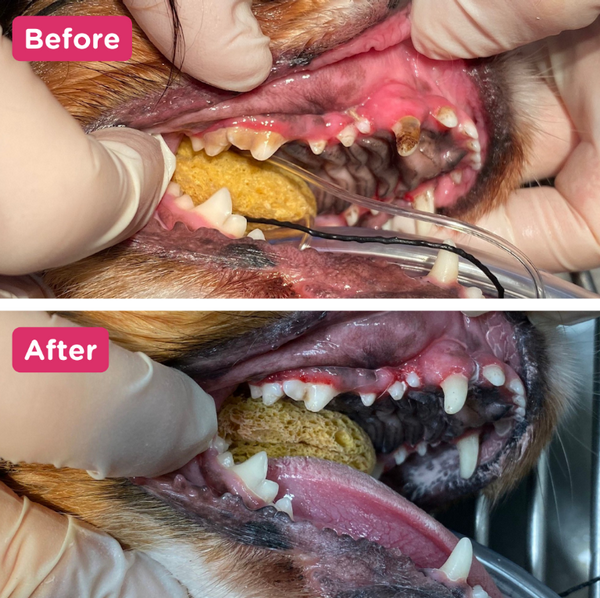Gingivitis in dogs
Gingivitis is the term used to describe inflammation of the gingiva (gums). Gingivitis occurs when bacteria and plaque accumulate in your dog's mouth, causing inflammation in the gum tissue where it meets the teeth. It marks the early stage of dog gum disease. If left untreated, gingivitis can lead to more serious problems such as periodontitis and tooth loss.
Dental disease is very common in dogs. Studies show that around 1.5 million dogs (12.5% of the population) are diagnosed with dental disease, including gingivitis, annually in the UK.
Brief summary
- Gingivitis in dogs is the early stage of gum disease caused by plaque buildup
- Symptoms include bad breath, red swollen gums, and drooling
- Treatment involves professional dental cleaning and home care like regular brushing and dental chews
- Certain breeds and older dogs are more susceptible, highlighting the importance of proper dental hygiene
 What causes gingivitis in dogs?
What causes gingivitis in dogs?
The main cause of gingivitis in dogs is plaque buildup. When your dog eats, tiny particles of food mix with the bacteria in their mouth and form a thin film which sticks to their teeth - this is called plaque. If this isn’t cleaned and removed, it hardens into tartar.
This tartar irritates the gums, leading to gingivitis. In general terms, gingivitis is caused by poor oral hygiene. Feeding your dog a healthy and balanced diet, and keeping up with oral care, such as tooth brushing, are important.
Some breeds are more susceptible than others. Brachycephalic breeds, like Pugs and British Bulldogs, or those with teeth that are close together might also have a higher chance of getting gingivitis because it's harder for them to chew properly, which means their teeth can trap more food and bacteria. Older dogs are also more prone to dental problems.

What are the main symptoms of gingivitis in dogs?
Gingivitis in dogs is quite easy to notice. Gingivitis symptoms include:
- Bad breath
- Red and swollen gums
- Bleeding gums, especially when brushing
- Tartar buildup, visible as yellow/brown areas on teeth
- Lack of appetite or not wanting to eat
- Drooling more often, saliva may be tinged with blood
- Less inclined to play ‘tug’ or ‘fetch and carry’ games
Is gingivitis in dogs painful?
Gingivitis can be extremely uncomfortable for dogs. This pain can have knock-on effects on the rest of your dog’s well-being. Because of the pain, they may not want to eat, causing weight loss. It might also be too painful for them to groom themselves, leading to dirty, matted fur.
In severe cases, gingivitis can cause your dog to become more irritable or aggressive.
Are certain breeds more likely to suffer from gingivitis?
Unfortunately, some breeds are at higher risk than others. These include:
As dogs age, they also become more at risk of gingivitis, which is why proper dental hygiene is so important.
What’s the best treatment for gingivitis in dogs?
The best treatment usually involves a dental clean at your vet practice, where they can remove any tartar build-up causing the gum inflammation and restore the gums to being healthy.
Your vet might also suggest a special toothpaste, mouthwash or diet to help keep your dog's teeth clean.
Regular brushing at home is also key to preventing plaque from building up again. Sometimes, if the gingivitis is severe and at risk of becoming periodontitis, your vet might prescribe antibiotics to clear up any infection.
How do you treat gingivitis in dogs at home?
Treating gingivitis in dogs at home focuses on good dental hygiene to keep their gums healthy. Here's what you can do:
Brush their teeth
It's the best way to keep plaque and tartar at bay. Use a dog-specific toothbrush and toothpaste (never use human toothpaste, as it can harm dogs). Start gently with short sessions and make it a positive experience so they start to look forward to it.
Dental chews and treats
These help reduce plaque and tartar buildup as your dog chews on them. Speak to your vet about which chews to choose and which to avoid.
Healthy diet
Feeding your dog a balanced diet will help their dental health. Some dog foods are specially formulated to help clean teeth as they eat.
Dental toys
You could get your dog some toys designed to help keep their teeth clean. These toys can be a great way to help manage dental health in a fun and engaging way.
Regular vet check-ups
Getting your dog's teeth regularly checked by a professional is important. They can perform a more thorough cleaning if necessary and check for any signs of dental diseases that need more advanced treatment. Pet Health Club members receive six-monthly check-ups and 10% off dental procedures as part of their membership benefits.
How to treat gingivitis in dogs
Getting rid of your dog’s gingivitis involves removing the cause, which means removing the plaque and tartar buildup. This will likely require a professional cleaning by your vet. Once their mouth is clean, keeping up with regular brushing and dental care at home can help prevent it from coming back.
It's also a good idea to have regular dental checkups with your vet to catch any signs of gingivitis before it becomes more serious.
Is gingivitis contagious in dogs?
Gingivitis itself isn't contagious from dog to dog because it's caused by the buildup of plaque and tartar specific to each dog's mouth. However, the bacteria that contribute to this buildup can be spread between dogs through saliva.
It’s important to remember that each dog's susceptibility to gingivitis depends on their dental health, diet and health rather than catching it from another dog.
Are there any studies into gingivitis in dogs?
Research from the Royal Veterinary College (RVC) has found that dental disease is not only common in dogs but can also cause them a lot of pain and lead to other serious health issues like kidney and heart disease. The RVC study, which is the biggest of its kind, looked at the health records of 22,333 dogs over a year and found that 12.5% had dental disease.
The study found that:
- About one in eight dogs gets dental disease each year
- Eighteen breeds are at a higher risk compared to mixed breed dogs, with Toy Poodles, Greyhounds, and Cavalier King Charles Spaniels being at the top
- Flat-faced breeds and spaniels are more likely to have dental problems, and smaller dogs are more at risk than larger breeds
- Older dogs are much more likely to have dental disease than younger ones
These findings show that gingivitis and dog gum disease are common, and proper dental hygiene is key to reducing the risks.
Want more advice on gingivitis in dogs?
If your dog is experiencing severe pain, sudden worsening of symptoms, or any emergency situation related to gingivitis, you should contact your vet immediately.
Making an appointment with your vet for advice on dog gingivitis and other gum health issues is also recommended. You can use our find a vet page to locate a vet near you or speak to a vet online using our video vet service.


